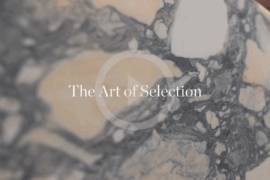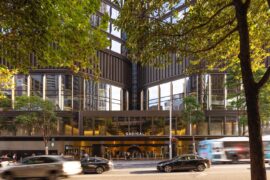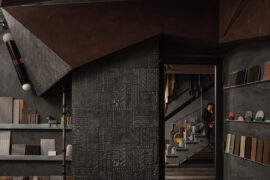Ground-breaking in its day and an icon of Australian campus architecture, the University of Sydney’s Fisher Library is celebrating 60 years with a very special reactivation.

November 13th, 2023
The modern Fisher Library has just celebrated 60 years with the unveiling of its newly reopened rooftop. Designed by NSW Government Architects Office, with architect Ted Farmer and designers Ken Woolley and Tom O’Mahoney, the first stage of construction was completed in 1962. The reactivation has been completed by Hames Sharley in collaboration with architect Trinh Tran from the University’s Design Engineering Planning & Sustainability team.
The building occupies a prominent position on the University of Sydney’s main campus, almost facing off against the prestigious Quadrangle which sits across lawns to its north-west. The library in fact lies cornered by the University’s two original axes which run north-south and east-west. The latter, less used today, connects the Quadrangle all the way down to City Road through Victoria Park, while the former, Eastern Avenue, is now the campus’ primary thoroughfare.

When it first opened, Fisher Library represented quite the modernist shock to a campus architecture still very much looking back to the aesthetics of Oxbridge and sandstone gravitas (Chemistry Building notwithstanding). The new facility instead indulged a rationalist and minimal architectural language with its strong concrete horizontals and pre-oxidised extruded bronze, while the later addition of the eight-storey ‘book-stack’ building added height.
The rooftop of the Undergraduate Wing provides special views of Sydney. With the Quadrangle on one side, the other looks out to an almost unimpeded vista of the city with Victoria Park below. Recent work to renovate the space followed a campaign by student newspaper, Honi Soit.
Related: When Lacaton & Vassal came to Sydney

“I feel immensely proud to be part of a generation of library custodians that has been able to reactivate that space,” says Brett Stamford, compliance and quality manager at Fisher Library, who also notes the use of tensile mesh in the new design. The addition, wrapping around the edge of the rooftop area, allows for some of the best qualities of the space – the views and ventilation – to remain, while maintaining safety and meeting heritage council requirements.
Reaching further back into history, the library was named after Thomas Fisher. Born in Sydney in 1820 and the son of former convicts John Fisher and Jemima Bolton (who met while serving as assigned convicts in Parramatta!), Fisher became a boot-making apprentice and set up his own business – T. Fisher. Ladies’ and Gentlemen’s Boot and Show Manufacturer – in Pitt Street. Living close to the University of Sydney in Darlington, he was known to walk through the University grounds left the University a grant of £32,000 (equivalent of more than $3.5 million today). Fittingly, the bequest came with instructions mentioning books and building.

The occasion of the 60th anniversary was marked by the opening of the rooftop for groups of visitors, some of whom were fortunate enough to see and subsequently partake of a detailed cake model of the whole building. Matt Devine, lecturer in education and heritage planner at the City of Sydney, was part of a panel with Dr Yulia Ulyannikova and Dr Sebastian Boell that reflected on the history, significance and life of the library.
“It’s a special place, a crossover point of different histories that stretch across some of Sydney’s many faces,” says Devine. “Whether appreciated from a strictly modernist architectural perspective or nostalgically as part of campus memories for generations of previous students, it’s a building that needs to be recognised – and the renewed rooftop creates an impetus for exactly that.”
The mid-century aesthetics and design philosophy brought open floorplans and decidedly modern programmatic features such as lounges and a music listening area (pictured above in the 1970s and 1980s). The original roof terrace was part of its popular appeal, and its reopening is something to be cherished by students and the wider Sydney architecture community alike.
University of Sydney
sydney.edu.au
Hames Sharley
hamessharley.com.au
Photography
Courtesy University of Sydney




INDESIGN is on instagram
Follow @indesignlive
A searchable and comprehensive guide for specifying leading products and their suppliers
Keep up to date with the latest and greatest from our industry BFF's!

London-based design duo Raw Edges have joined forces with Established & Sons and Tongue & Groove to introduce Wall to Wall – a hand-stained, “living collection” that transforms parquet flooring into a canvas of colour, pattern, and possibility.

A curated exhibition in Frederiksstaden captures the spirit of Australian design

CDK Stone’s Natasha Stengos takes us through its Alexandria Selection Centre, where stone choice becomes a sensory experience – from curated spaces, crafted details and a colour-organised selection floor.

Across four decades, Leone Lorrimer LFRAIA GAICD reshaped Australian architecture through strategic vision, global influence and fearless leadership.
The internet never sleeps! Here's the stuff you might have missed

Rising above the new Sydney Metro Gadigal Station on Pitt Street, Investa’s Parkline Place is redefining the office property aesthetic.

Bangalore studio Multitude of Sins elevates true leftovers — not surplus — into a richly layered workspace where waste materials become narrative, structure and sculptural expression.

Central Station by Woods Bagot in collaboration with John McAslan + Partners has been named one of two joint winners of The Building category at the INDE.Awards 2025. Recognised alongside BVN’s Sirius Redevelopment, the project redefines Sydney’s historic transport hub through a transformative design that connects heritage with the demands of a modern, growing city.